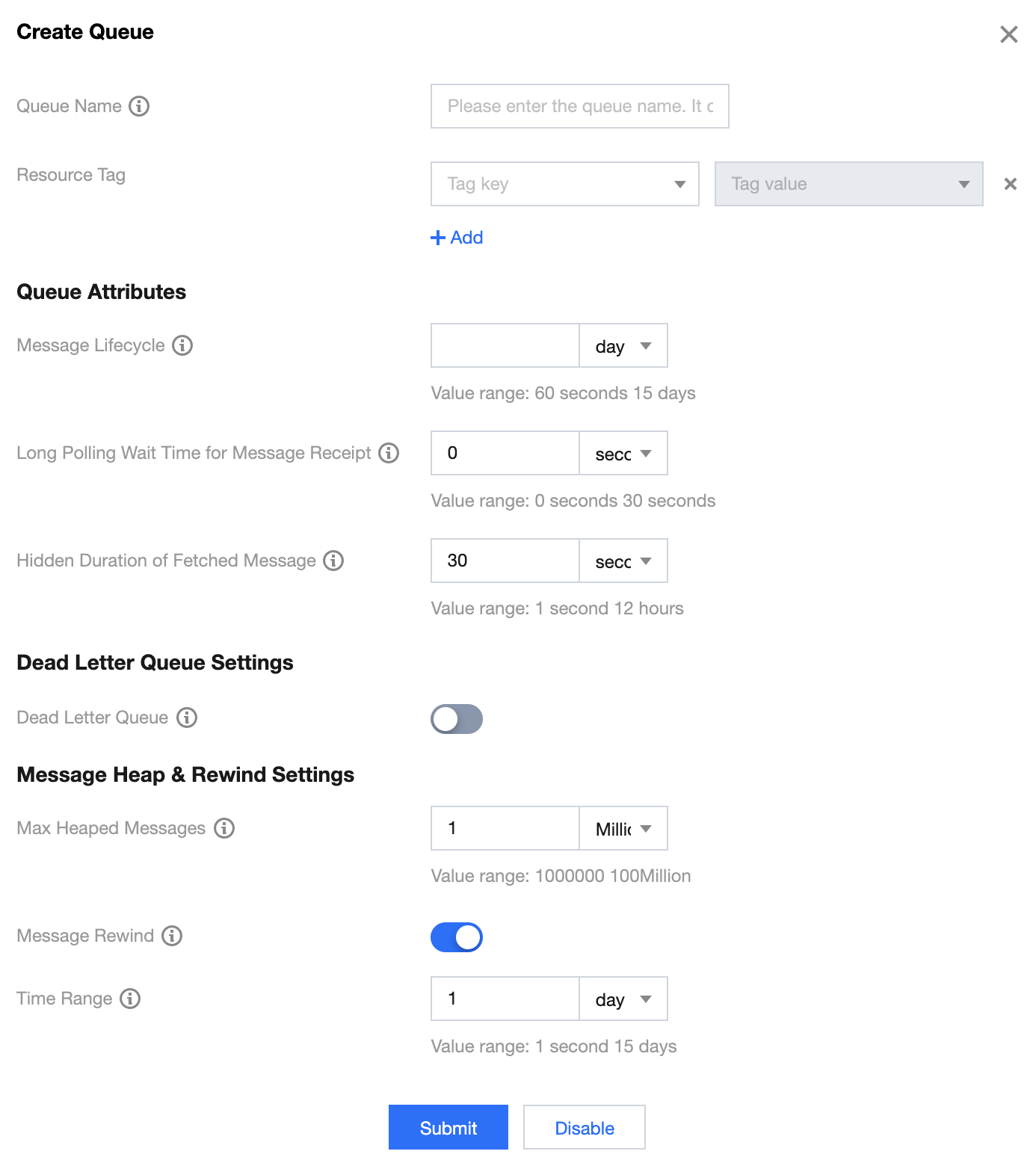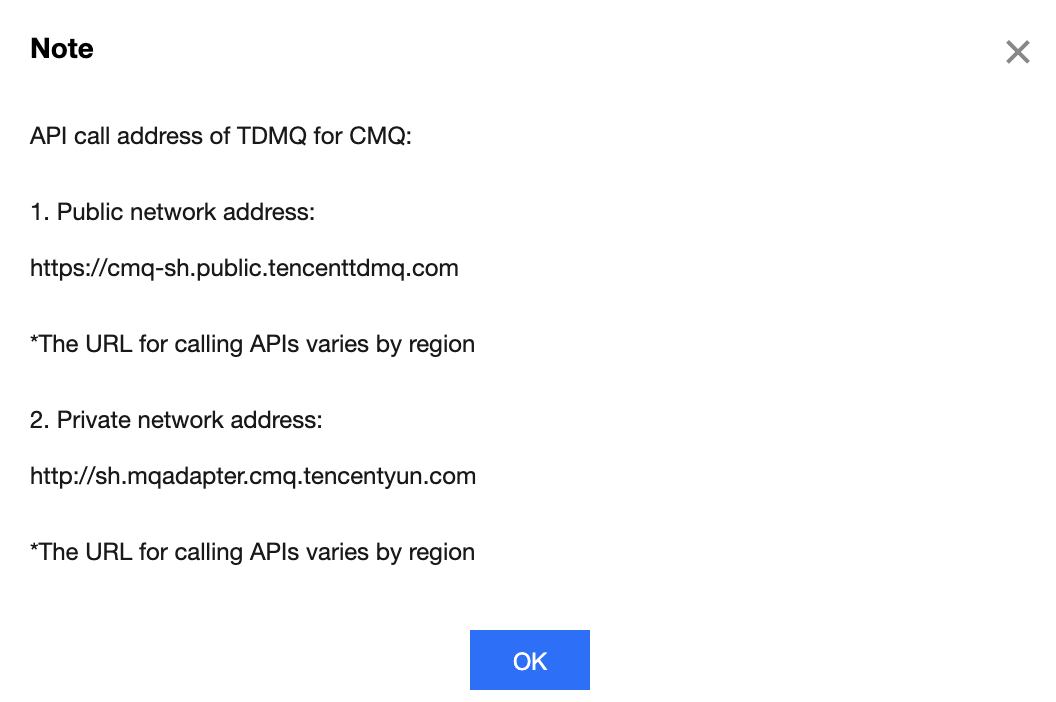队列模型快速入门
最后更新时间:2024-01-03 10:15:44
操作场景
本文为您介绍从零开始创建一个队列服务并使用 Java SDK 进行收发消息测试的方法,帮助您快速了解客户端接入 TDMQ CMQ 版所需的基本操作。
前提条件
操作步骤
步骤1:创建队列服务
1. 登录 TDMQ CMQ 版控制台。
2. 在左侧导航栏选择队列服务,选择地域后,单击新建,配置队列服务相关属性值。


属性 | 说明 | 取值 |
队列名称 | QueueName,为队列的名称。 | 作为资源的唯一标识,调用 API 接口进行操作时,以 Queue name 为准,创建成功后无法修改。不区分大小写,相同字母即会判定为同名,并不能以 -retry 和 -dlq 结尾。 |
资源标签 | - | |
消息最长未确认时间 | 如果消费客户端在获取到消息后超过此时间仍未进行消息的确认,则服务端会自动确认该消息。 | 范围在30秒到12小时 |
消息接收长轮询等待时间 | PollingWaitSeconds,长轮询等待时,一个消息消费请求只会在取到有效消息或长轮询超时时才返回响应,类似于 Ajax 请求的长轮询。 | 范围在0秒到30秒,推荐设置为3秒,设置过高可能造成消息重复的概率提升。 |
取出消息隐藏时长 | 该项为队列的 VisibilityTimeout 属性,每条 Message 都有个默认的VisibilityTimeout,Worker 在接收到消息后,timeout 就开始计时了。如果 Worker 在 timeout 时间内没能处理完 Message,那么消息就有可能被其他 Worker 接收到并处理。 | 范围在1秒到12小时 |
不可见消息数量上限 | 不可见消息过多一般是客户端未及时 ACK 导致的,产生不可见消息会消耗一定的内存,因此为每个队列设置了一定的容量上限。 | 100000条,如需提升额度,请联系技术支持。 |
消息堆积容量上限 | 消息堆积一般是生产速率大于消费速率或者消费出现阻塞导致的,产生堆积会消耗一定的磁盘存储,因此为每个队列设置了一定的容量上限。 | 10GB,如需提升额度,请联系技术支持。 |
死信队列 | 死信队列用于处理无法被正常消费的消息。达到最大重试次数后,若消费依然失败,则表明消费者在正常情况下无法正确地消费该消息,此时,MQ 不会立刻将消息丢弃,而是将其发送到该消费者对应的特殊队列中。 | - |
消息回溯 | 若未开启“消息回溯”能力,则消费者已消费,且确认删除的消息,会立即删除,开启该功能时,须指定回溯的“可回溯周期”。 | “可回溯周期”的范围,必须小于等于消息的生命周期。建议将回溯周期与消息的生命周期设置为相同的值,便于定位问题。 |
可回溯时间范围 | 若开启“消息回溯”能力,则消费者确认删除的消息不会立即删除,会持续保存到此处配置的最大时间。 | 时间范围:1天 - 15天,设置较长可能会产生昂贵的存储费用。最大可回溯时间点 = 当前时间 - 设置的可回溯时间范围。消息生产时间在这个值之前的不可回溯。 |
可回溯存储空间 | 开启回溯消息后,如果持久存储的消息超过此最大存储空间,则会从后向前删除(优先删除旧数据)。 | 存储空间范围:1GB - 10GB,设置较大可能会产生昂贵的存储费用。 |
3. 单击提交,在队列服务列表可以看到创建好的队列服务。
步骤2:使用 SDK 收发消息
说明:
1. 下载 Demo 并解压。
2. 引入 CMQ 客户端相关依赖。
<!-- cmq sdk --><!-- cmq sdk --><dependency> <groupId>com.qcloud</groupId> <artifactId>cmq-http-client</artifactId> <version>1.0.7</version></dependency><!-- 云API sdk --><dependency> <groupId>com.tencentcloudapi</groupId> <artifactId>tencentcloud-sdk-java</artifactId> <version>3.1.423</version></dependency>
3. 发送消息。
Account account = new Account(SERVER_ENDPOINT, SECRET_ID, SECRET_KEY);Queue queue = account.getQueue(queueName);String msg = "hello client, this is a message. Time:" + new Date();CmqResponse response = queue.send(msg);
参数 | 说明 |
SERVER_ENDPOINT |  |
SECRET_ID、SECRET_KEY |  |
queueName |
4. 消费消息。
Account account = new Account(SERVER_ENDPOINT, SECRET_ID, SECRET_KEY);Queue queue = account.getQueue(queueName);Message message = queue.receiveMessage();// 消费成功,删除消息。未删除的消息,将在一定时间后可重新投递queue.deleteMessage(message.receiptHandle);
参数 | 说明 |
SERVER_ENDPOINT |  |
SECRET_ID、SECRET_KEY |  |
queueName |
说明:
文档反馈

